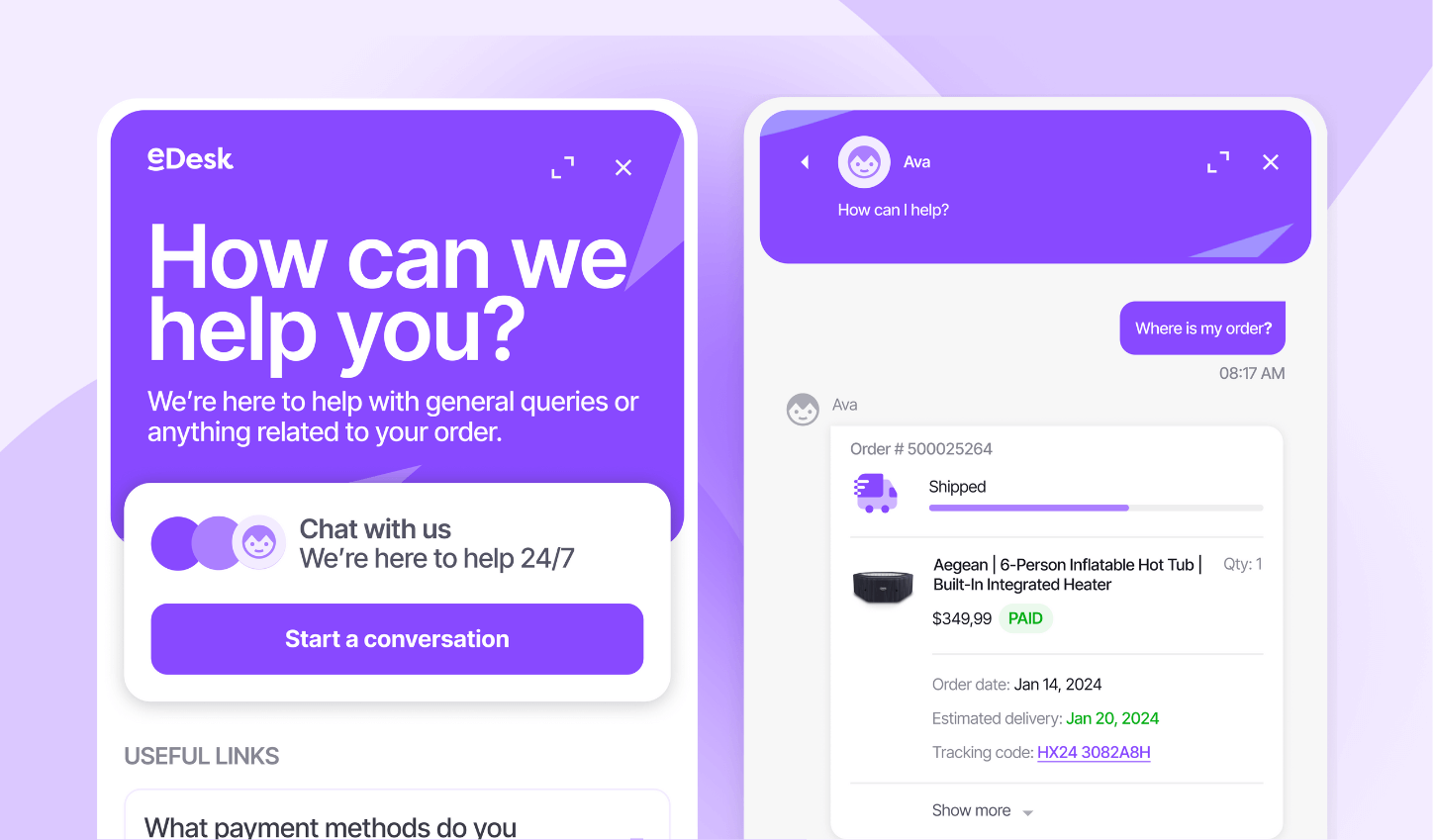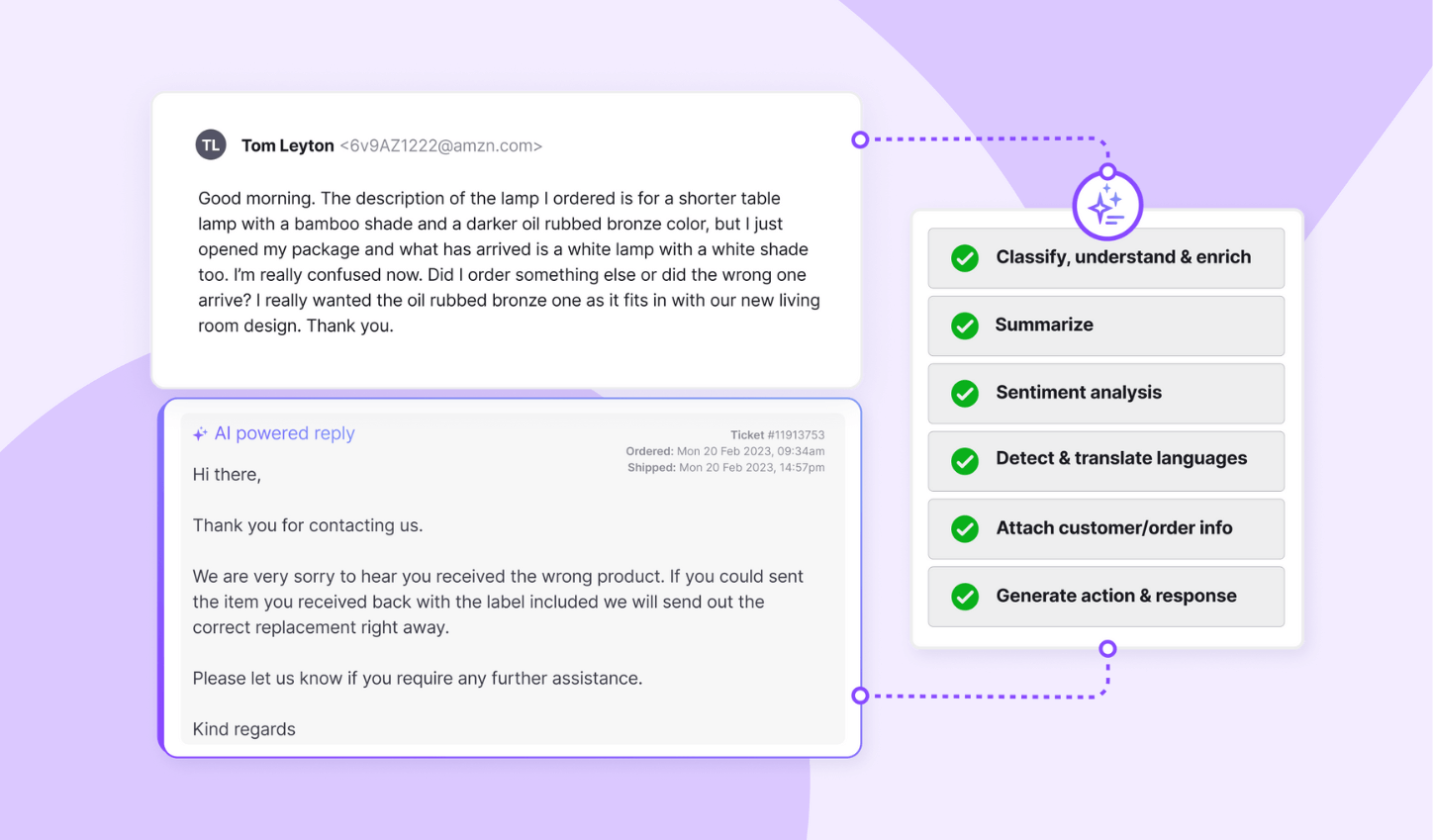The rapid evolution of artificial intelligence in the last ten years has transformed how industries operate all over the world. From cybersecurity to healthcare, AI is helping to automate processes and make breakthroughs in every sector. In the eCommerce industry, conversational AI is playing a crucial role in improving customer experiences, streamlining support, and boosting sales. Conversational AI includes chatbots and virtual assistants that allow businesses to engage with customers in real time, providing personalized recommendations, handling inquiries, and facilitating transactions. Global spending for conversational AI in eCommerce was estimated at $13.6 billion in 2024 and is projected to reach $290 billion by 2025, showing just how rapidly this technology is changing the industry.
In this guide, we will explore the benefits of implementing conversational AI in eCommerce, best practices for its deployment, and how leading platforms like eDesk’s AVA chatbot can help businesses enhance customer engagement and operational efficiency.
What is Conversational AI?
Conversational AI refers to artificial intelligence systems that can talk to humans in a natural, ‘conversational’ way using tools like natural language processing (NLP) and machine learning (ML). In eCommerce, this technology is widely used to automate customer service, assist with product recommendations, and streamline the shopping experience. Conversational AI’s development in eCommerce represents the next evolution of customer service by bridging the gap between digital interactions and personalized shopping experiences.

What Does Conversational AI Look Like?
1. Social Messaging
Many brands use platforms like Facebook Messenger and WhatsApp to engage customers through real-time messaging, offering support and product recommendations within social apps.
2. Chatbots
AI-powered chatbots provide instant customer service, answering frequently asked questions, guiding shoppers through product selections, and even processing orders.
3. SMS & MMS Marketing
Text messaging enables brands to communicate directly with customers, offering promotions, updates, and support. MMS takes this further by integrating images and videos into conversations.
4. eCommerce Search Bars
Search bars are evolving from one-way input tools into interactive assistants. With AI, they can engage in two-way conversations, refining product search results and improving customer satisfaction.
Why Use Conversational AI in eCommerce?
1. Enhanced Customer Support
Conversational AI enables businesses to provide instant and round-the-clock customer support. Unlike human agents, AI-powered chatbots can handle multiple queries simultaneously, reducing wait times and improving customer satisfaction.
Example: eDesk’s AI eCommerce chatbot efficiently resolves customer queries related to orders, returns, and product availability, helping businesses deliver exceptional customer service.
2. Personalized Shopping Experiences
AI-driven chatbots analyze customer data to provide personalized recommendations based on browsing behavior, past purchases, and preferences. This enhances the shopping experience for customers and increases the likelihood of conversions.
Example: A 2025 survey revealed that over 60% of consumers have utilized conversational AI tools, such as ChatGPT and Gemini, for online shopping. Furthermore, 58% of respondents believe AI tools have improved their online shopping experiences by providing personalized recommendations and efficient customer support. These insights highlight the growing reliance on AI-driven interactions to enhance the eCommerce experience.
3. Increased Sales and Conversions
By engaging with customers in real time, conversational AI chatbots can assist in product discovery, answer concerns, and guide users through checkout. This reduces cart abandonment rates and enhances conversion rates.
Example: Conversational AI in sales can drive up to 30% higher conversion rates by proactively engaging customers with personalized promotions and answering their queries instantly. Additionally, 53% of consumers indicated they are more likely to engage with brands that offer AI-driven conversational interfaces, emphasizing the importance for eCommerce businesses to adopt these technologies to meet evolving customer expectations.
4. Cost Efficiency
Deploying conversational AI chatbots in eCommerce can significantly reduce the need for large customer service teams, cutting operational costs while maintaining high service levels.
5. Multilingual Support
AI chatbots can interact with customers in multiple languages, allowing businesses to expand globally without hiring multilingual support staff, as well as work with customers from all over the globe around the clock.

How to Implement Conversational AI in Your eCommerce Business?
Step 1: Define Your Objectives
Before implementing conversational AI in your eCommerce business, determine your goals. Are you looking to improve customer service, increase sales, or streamline operations? Having clear objectives helps in selecting the right AI solution and designing effective conversational flows.
Step 2: Choose the Right AI Solution
Selecting the best conversational AI chatbot platform for eCommerce depends on your business needs. Key factors to consider include:
- Integration capabilities: The AI should work seamlessly with your existing eCommerce platform (e.g., Shopify, WooCommerce, Magento).
- Customization options: Ensure the chatbot can be tailored to your brand’s tone and style.
- Analytics and reporting: AI solutions should provide insights into customer interactions and performance metrics.
Example: eDesk’s AVA AI chatbot is a robust solution tailored for eCommerce businesses, offering automation for common customer queries and seamless integration with online marketplaces.
Step 3: Design Conversational Flows
A well-structured conversational flow ensures that AI interactions feel natural and intuitive. This includes:
- Greeting customers and identifying their intent.
- Offering relevant responses or guiding users to human agents when necessary.
- Providing options for self-service, such as FAQs or order tracking.
Step 4: Train and Test the AI
Conversational AI chatbot development services for eCommerce involve continuous training to improve accuracy and efficiency. This includes feeding the AI with historical customer data, refining responses, and conducting A/B testing to optimize performance.
Step 5: Deploy and Monitor Performance
After launching your conversational AI in eCommerce, monitor key performance indicators (KPIs) such as:
- Response accuracy and resolution rates.
- Customer satisfaction scores.
- Conversion rates from chatbot interactions.
By analyzing these metrics, your business can make necessary adjustments to improve AI performance over time.
Real-World Examples of Conversational AI in Action
1. Amazon’s Alexa+ for Shopping
Amazon’s advanced AI-powered assistant, Alexa+, enhances customer engagement by offering personalized shopping assistance and seamless voice-enabled transactions.
2. AI-Driven Ordering at Pizza My Heart
A California-based pizza chain introduced “Jimmy the Surfer,” an AI chatbot developed by Palona AI, enabling customers to place orders via text, improving efficiency and customer satisfaction.
Future Trends in Conversational AI for eCommerce
Conversational AI is already playing a huge part in the eCommerce industry, and this trend is only sure to grow. As time goes on, customers will come to expect the ease and convenience that conversational eCommerce provides, and expect every brand they engage with online to deliver personalized experiences. With this in mind, let’s take a look at potential future trends:
- Voice Commerce Growth: The adoption of voice-enabled shopping assistants will continue to rise.
- AI-Generated Content: AI will be used to create personalized marketing messages and product descriptions.
- Hyper-Personalization: AI will leverage customer data to provide highly customized shopping experiences.
- Integration with Augmented Reality (AR): Conversational AI will work alongside AR to provide immersive shopping experiences.
How to Integrate Conversational AI
Implementing conversational AI in eCommerce can transform customer interactions, improve efficiency, and drive revenue growth. By carefully selecting the right conversational AI chatbot platform for eCommerce, businesses can provide superior customer experiences, boost sales, and establish a competitive edge in the digital marketplace.
For those looking to integrate conversational AI seamlessly, platforms like eDesk’s AI chatbot offer tailored solutions to enhance customer engagement and support. By exploring examples of AI in customer service, businesses can gain valuable insights into effective implementation strategies. Ready to take the next step? Book a demo today.






